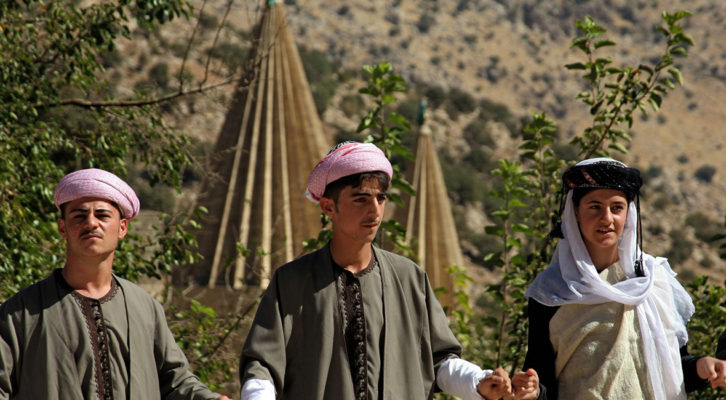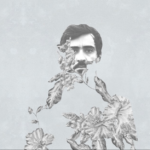Following the closure of Yazda, a Yazidi humanitarian and human rights organization, by the KDP asa’ish (security police affiliated with Kurdistan’s largest political party, the Kurdistan Democratic Party) on January 2, 2017 in Dohuk, people have been asking many questions about why this took place. Fortunately, the government has now reversed its position on the closure and Yazda has reopened. Nevertheless, this episode points to some serious political issues that impact the status of the Yazidi minority in Kurdistan. I will explore these issues in this article.
Having left the country last August after a year of leading Yazda’s Iraq and Kurdistan-based operations, I will not speak for Yazda now. But I will present my opinions on the Yazidi situation and discuss the feelings of the Yazidi people, which may shed light on why Yazda was persecuted by the authorities.
A Broken Relationship
Understanding the tension between the KDP government and the Yazidis requires investigating why the KDP generally has an adverse relationship with the majority of the Yazidis. In fact, those Yazidis who become close to the KDP political establishment usually lose favor and respect among much of their community. This is because the agendas of the KDP often conflict with the welfare of the Yazidi people, and a number of crucial issues jeopardizing the future of the Yazidis have come to a head this past year.
What do I mean by a clash of interests between the Yazidis and the KDP? Ever since the fall of Saddam, Kurdistan has worked hard to expand the boundaries of what is hoped will be a future independent Kurdistan. These aspirations and efforts are noble considering the many ways that Kurds have been victimized by the various regimes in Iraq through history. But many Kurds today do not realize that despite this history of victimization, their newfound power also creates the possibility and risk of victimizing others—especially the minorities who often inhabit the disputed territories that Kurdistan would like to appropriate.
The Sheikhan district in the Nineveh Plain used to be a Yazidi-majority area, but just since the fall of Saddam, it has been targeted with a program of demographic change that has involved settling Sunni Kurds in the area in order to strengthen the claim that it should be included within the Kurdistan Region. This program is similar to the Arabization schemes to which Saddam subjected the Kurds, and Yazidis call it “Kurdification.” Sheikhan, a historic Yazidi homeland, is now a Muslim-majority area, a change that occurred entirely post-Saddam. Even the Mir, the highest Yazidi religious authority, spoke to US officials about this problem.
In Shingal (“Sinjar” in Arabic) after 2003, the KDP quickly became a powerful presence. Many Yazidis were open to pursuing a future for Shingal as part of Kurdistan, hoping that life under Kurdish government would offer greater rights for minorities than had been the case under Ba’thist rule. But from those early days, the KDP asa’ish began systematically arresting and intimidating Yazidi civilians who joined competing political parties, especially those who favored keeping Shingal’s administration under the authority of the central government. Though services in Shingal are almost entirely paid for by Baghdad, the KDP bullied non-KDP Nineveh officials out of Shingal so that it could maintain administrative control. Shingal’s “mayors” (qaymaqam), including the current one, are never elected by the local people, but are appointed by the party and are, of course, always party loyalists. Despite the fact that the KDP completely dominated Shingal, it remained one of Iraq’s least developed and most marginalized districts.
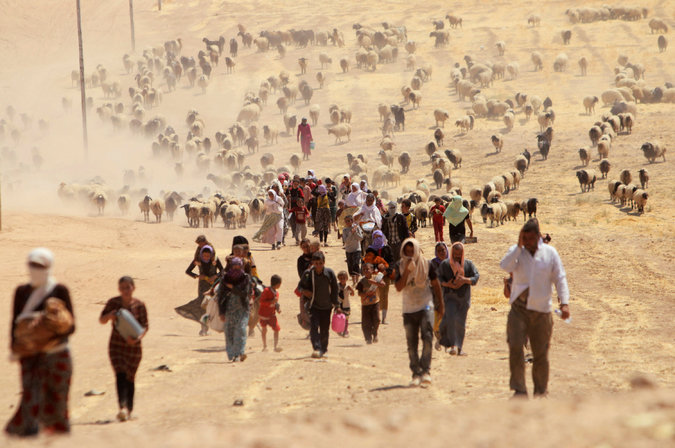
Yezidis escaping ISIS invasion in Shingal 2014
Because of this legacy, by 2014 the majority of the Yazidis of Shingal already resented KDP control; the Peshmerga withdrawal the morning of the genocide was simply the final straw, severing trust with the KDP forever. But because of KDP policy, the Yazidi situation has become even worse following the genocide, which is the main issue that this article will explore.
Today there is a bitter political standoff in Shingal that is exacerbating the already poor relations between the Shingali Yazidis and the KDP. In order to understand the development of this conflict, we must first clarify some key aspects of how the genocide unfolded, and also debunk several myths propagated by government officials regarding the day of the genocide.
Setting the Record Straight on Shingal
Though everyone is familiar with the Peshmerga withdrawal on August 3, 2014, the day the Yazidi Genocide began, many citizens of Kurdistan and Iraq have been led to accept three key excuses advanced by KDP officials trying to justify the withdrawal: 1) that the IS (Islamic State) invasion of Shingal was a surprise attack; 2) that the Peshmerga lacked adequate weaponry to defend local Yazidis from IS; and 3) that the Peshmerga defended but IS was just too powerful and the front line collapsed.
The first claim is obviously false since everyone knows that Mosul was conquered in early June, almost two months prior to the attack on Shingal. During the period between the conquest of Mosul and the Yazidi Genocide, IS gradually solidified control over the Arab areas south and east of Shingal. Tel Afar was conquered during that period, and IS forces grew increasingly close to Shingal. In fact, several small attacks occurred on outlying Yazidi villages southeast—and even north—of Shingal, prior to August 3. Tel Banat was attacked several times. In other words: The IS threat was well-known and there was plenty of time to prepare for any potential conflict, and to put an evacuation plan in place for civilians.
The second claim is an attempt to side-step responsibility for the failure to defend the Yazidis. It ignores the fact that after the Iraqi military dissolved in the areas near Mosul, Kurdish forces seized control of Iraqi weapons depots and snatched up all of the weaponry and ammunition. This included Kesek, which housed the “regional ammunitions center” that provided weapons and ammunitions to the 2nd and 3rd Iraqi army divisions and to military academies in Zakho and Sulaimani. Moreover, when Iraqi army forces were retreating from Tel Afar and leaving the Shingal area, they were unable to retreat to Baghdad without passing through Kurdish-controlled territory. KDP-affiliated forces, therefore, forced these sections of the Iraqi army to hand over all of their weapons, ammunition, equipment, and military vehicles—at the KDP headquarters in Shingal, no less. This included the 10th brigade of the 3rd division and the 11th brigade of the 3rd division of the Iraqi army. Despite holding out and defending Tel Afar for some time, once these troops were pushed out by IS, they were effectively looted by KDP forces and sent back to Baghdad wearing civilian clothing. But beyond this evidence contravening the claim that the Peshmerga lacked adequate weaponry, the question should be asked as to how the Syrian YPG forces, who have smaller weapons, inferior vehicles, and are generally less equipped than the Peshmerga, were able to enter an unfamiliar area that they had never controlled, without the high-ground advantage, and fight through IS lines after IS had already established itself in the area and surrounded the mountain. The point is that the alleged superiority of IS weaponry had nothing to do with the withdrawal. Keep in mind that there are numerous locations in the foothills of Shingal Mountain where just a handful of Yazidi farmers with old rifles were able to prevent the jihadists from ascending into these enclaves—such is the advantage of the higher ground. The idea that the Peshmerga had to flee to Dohuk, rather than move to the protection of the mountain while providing cover to the evacuating civilians, is patently absurd.
But most important is the third claim, that the Peshmerga’s lines were overwhelmed by the might of the IS jihadists. This claim is demonstrably false in light of the way that the withdrawal was conducted. The withdrawal was not a chaotic, haphazard fleeing after engaging the enemy; Shingal Mountain is 72 kilometers long, and with the security presence in many of the towns all around, it would be nearly impossible that every single “front line” would collapse simultaneously. If troops had been overwhelmed in one location, many other troops would have been able to hold their ground in other locations. But the withdrawal was collective (involving almost all security and militia personnel in the entire district), and was conducted in an organized fashion, with all weapons and military vehicles being transported out of Shingal and back to Kurdistan. When local Yazidi civilians saw that the Peshmerga were abandoning them, they begged them to at least leave behind the weapons so that they could defend their own families. But the Peshmerga refused. According to hundreds of survivor accounts, this planned withdrawal occurred before the jihadists reached Shingal. These countless testimonies of civilian eyewitnesses were corroborated by a Peshmerga leader named Sime Mulla Muhammad, responsible for troops in Shingal, who disclosed to the Xendan newspaper in an interview published August 3, 2016 that he withdrew his men without engaging the enemy, prior to the arrival of the jihadists, after it was known that IS was moving on the area. Beyond all of this, not only did Qasim Shesho (the current leader of the KDP Peshmerga in Shingal) state for the record that the Peshmerga fled before the civilians could evacuate, but President Barzani’s reaction to the withdrawal also dispelled any notion of the front line breaking, as in early August 2014 he referred to the “negligence” of those in command and formed a committee to investigate possible desertions.
The facts presented above become even more painful when considering that the day before the genocide, August 2, 2014, local people in Shingal knew that IS was mobilizing. They could sense that an attack might be imminent. Yazidis asked those responsible for security if the people should evacuate. Peshmerga leaders gave assurances to the people that they would be protected, and told them to stay in their villages. In some cases, asa’ish even prevented families from evacuating; some families had loaded up their cars and were attempting to drive to Kurdistan but were turned back at the checkpoints guarding village entrances.
I have presented this background to make it perfectly clear why the trust of the Shingali Yazidis in the KDP was irreparably shattered on August 3. This should also explain why the YPG and PKK forces that entered Shingal to defend the Yazidis won so many hearts and minds. Not only did those forces save the lives of tens of thousands of Yazidis that had been left to die, but they enabled the local Yazidis to hold the front line against IS for the next 15 months, killing more jihadists than any other militia.
Preventing Yazidis from Returning and Rebuilding: The Economic Blockade
This brings us to the present political conflict that is victimizing the Yazidis. As is common knowledge, after the PKK-affiliated forces rescued the Yazidis in the absence of the Peshmerga, they helped the Yazidis form a local militia known as the YBŞ. This force is affiliated with the PKK but is primarily comprised of local Shingali Yazidis who came together to defend their own families and homes.
The KDP wants the YBŞ to disappear. They want all non-KDP militias to dissolve so that the KDP Peshmerga can again enjoy full control of Shingal and return to business as usual. But the KDP knows that if the displaced Yazidis now living in the camps in Dohuk return to Shingal, they will be more likely to support a rival militia, like the YBŞ, because they have no loyalty for the KDP.
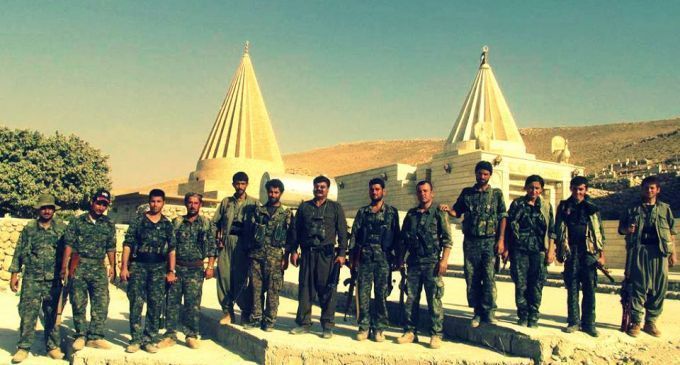
YBS fighters in Lalish
And that brings us to the most discouraging of facts, the economic blockade of Shingal, which is the KDP’s disgraceful strategy to keep Yazidi families, who survived a genocide, trapped in camps that they have lived in for over two and a half years, rather than allowing them to return to Shingal. The north side of Shingal Mountain has been free of the IS presence since December 2014, without any IS-related security incident. The north side has eight major towns and over 25 smaller locations inhabited by Yazidis. It is viable for return and reconstruction, and several thousand Yazidi families have already taken up residence there, trying to rebuild their destroyed homes and farms. However, for over a year now, the KDP asa’ish have been effectively starving these families—and preventing the return of thousands more who would like to begin rebuilding a normal life—through an economic blockade. At the primary checkpoint controlling access to Shingal from Dohuk (Fishkhabour, near Suheila village), asa’ish do not allow Yazidis to bring goods to Shingal upon which a basic economy depends, such as livestock or most products for retail shops. Even beyond the commercial level, Yazidi families are not allowed to bring into Shingal basic household goods and foodstuffs upon which any family depends for their livelihood. There are countless examples of what is not allowed though. Here are a few examples that I gathered personally through my own conversations with affected families, farmers, and shop owners:
– Auto mechanics are not allowed to bring in spare parts for vehicles, including parts for pickup trucks and tractors, both depended upon by farmers.
– Small amounts of bulk food items for the use of a single family (such as a single bag of sugar, flour, or rice) are generally not allowed through.
– Farmers report not being allowed to bring motor oil through which is needed for their harvester machines (Shingal depends on wheat and barley farming). Fuel (for gas stations) is also occasionally restricted.
– Cement and cinderblocks needed for the rebuilding of homes destroyed by IS are often not allowed through.
– Many families have been prevented from bringing a single sheep or lamb through the checkpoint.
– Fertilizer is not allowed through. The asa’ish claim that it is to prevent terrorists from making bombs; this is not a risk among poor Yazidi farmers. Without fertilizer, farmers lose 50% to 70% of their yield.
– Farmers are not being allowed to being ordinary farming equipment, such as irrigation supplies, to Shingal.
– The headmasters of schools in Shingal have not been allowed to bring basic school supplies (such as paper, a single printer, or a single laptop) through the checkpoint, and have also been prevented from bringing fixtures for the schools, such as well pumps for the schools’ water systems.
– Displaced families trying to return have been turned back to the camps when attempting to transport their own furniture or tents in which they need to live while rebuilding their destroyed homes.
– Veterinary medicine has not been allowed through. Shingal’s families live off of herds but shop owners who sell veterinary medicine are not able to reopen their shops in Snune or the other collective villages because of the restrictions.
As an unannounced and therefore “unofficial” blockade, it is selectively enforced. Those with close ties to the government, asa’ish, or Peshmerga are sometimes allowed to bring some goods through. A few basic retail items are allowed through for the shops in Snune. This allows government officials to deny the existence of the blockade when challenged about it. But even when certain goods are allowed through, drivers are often treated roughly and humiliated by the asa’ish, being forced to unload their entire delivery (crates of vegetables, for example) in the sun. Many drivers for hire have simply given up trying to transport goods to Shingal. When some farmers complained about the restrictions on moving ordinary goods, government officials told them that they must apply for certain permits in order to bring goods to Shingal (permits that never existed before and that no one had heard of). Farmers that have tried to navigate this process are given a runaround, being sent from office to office, and the process—just to get official authorization to take farming supplies to one’s small farm—can take months. This can mean missing a planting or harvesting season. Most people simply give up trying. One farmer who finally succeeded in securing a permission document from the Dohuk governorate was still blocked from transporting the goods to Shingal by the asa’ish at the checkpoint: there’s no guarantee that the asa’ish will respect government documents.
Human Rights Watch investigated this blockade and recently issued a report, condemning the government for actively preventing reconstruction. I have personally always been in favor of reconstruction so that Yazidis can have a future in their homeland instead of being forced to emigrate. Emigration destroys the traditional diversity of the local society and puts the heritage of small minorities at risk. However, current policies actively prevent Yazidi families from returning and rebuilding, which produces hopelessness and prompts greater emigration from the country.
Political Violence toward Yazidis
This situation becomes even worse. Not only are families who were targeted with genocide and are now in their third year of living in camps prevented from returning home to resume normal lives, they are also punished severely if they complain about this situation. The asa’ish maintain strict control of Yazidi activities in the camps. Yazidis in the camps are generally not allowed to organize a public meeting unless it is for an activity related to an official political party. This included memorial gatherings to commemorate the anniversary of the genocide, last August, which asa’ish feared could turn into opportunities where dissent would be expressed. Yazidis in the camps holding peaceful demonstrations or speaking out on social media to protest the political policies that harm them have often been arrested, beaten, or threatened. In general, the asa’ish have succeeding in suppressing the voices of Yazidis who are broken and frustrated about their situation.
Worst of all is the political violence targeting Yazidis who join rival militias. These young people—and their families—can be persecuted through arrests, jailing, interrogations, and beatings. Young Yazidi men and women who join the YBŞ cannot visit their displaced relatives in the IDP camps in Dohuk, or else they will be arrested. In fact, KDP asa’ish have arrested poor taxi drivers accused of carrying YBŞ-affiliated passengers as customers in their taxis. Some taxi drivers have no knowledge of the identities of their paying customers, but have been arrested and jailed all the same. Some young men and women have not seen their families in the camps—only a three-hour drive away—for over two years for fear of being arrested.
One of my employees when I was leading Yazda in Iraq and Kurdistan was an uneducated, destitute man who worked as a cleaner in Yazda’s health care center. He had no interest in politics, but several of his grown children decided that they would join the YBŞ to defend their homeland. One day, he was taken by the asa’ish to an office where he was interrogated and told that he would be made to disappear (i.e., imprisoned without charges or trial) if he did not convince his children to disaffiliate from the YBŞ. He could not convince them to leave their cause of defending Shingal, so he had to leave the Kurdistan Region. He moved back to Shingal where he has no work and no resources, out of fear for his safety. Such stories are commonplace.
The political persecution of Yazidis who voice criticism of the government is so severe that it has prompted many families to immigrate to Europe. A number of Yazidi activists and journalists, not affiliated with any party, received threats against their families from the asa’ish because they spoke out. They chose to leave the country rather than live in fear. Individuals and families are not the only ones targeted; organizations are also victims of the crackdown on free speech.
Yazda Iraq is not the first local Yazidi organization to be shut down by the KDP since the genocide. Rainbow, a Yazidi-created project doing activities with children in Mamilian camp, was shut down in late 2015 after some of its volunteers joined peaceful demonstrations against the treatment of the Yazidis. Hezar Dinar, or the “Thousand Dinar” campaign, was an influential project with a huge impact. Yazidi volunteers collected small donations from large numbers of local people to redistribute to the needy in the camps. The project was apolitical but was shut down just before summer 2016 by KDP asa’ish after some of its members were seen in a photograph holding a non-KDP flag. Yazda was simply the latest casualty in an ongoing campaign to silence the free expression of any critical sentiments among the Yazidis.
While working in the KRI, I was frequently attacked by Kurdish officials if I voiced even the smallest concern about the situation and how it was affecting the survivors of the genocide. If I mentioned in a UN cluster meeting that the asa’ish were preventing certain goods from being transported to Shingal, I was ridiculed publicly by the government representative and accused of being a “troublemaker.” Of course, it was the government that was making trouble for the victims of the genocide.
Individuals or organizations expressing any criticism of KDP policy in Shingal were often accused of “supporting the PKK.” This is a strange allegation; critiquing harmful KDP policy does not constitute support for the PKK.
Aside from the competition in Shingal, the political dynamics inside the Kurdistan Region were also unhealthy. In the spring of 2016, I was visited by a PUK Peshmerga captain who commanded the small contingent of PUK Peshmerga in Shingal. He described to me how he had a large shipment of medicine that he was trying to bring to Shingal but was being prevented from doing so by the KDP asa’ish, despite being a Peshmerga leader. During my period of work in the country, the primary health centers in the Shingal region suffered from a lack of medicine. I am not speaking of the health centers created by the PKK to serve displaced Yazidis on top of the mountain; I am referring to the established, government-run health centers serving the collective villages on the north side of the mountain. These health centers are part of Nineveh administration and are responsible for the health care of several thousand local Yazidi families that had returned to Shingal. However, the managers of those health centers frequently disclosed to me that they were not being allowed to bring any shipment of medicine originating with the Nineveh government to their centers. I visited such centers personally and saw that their stores of medicine were empty. In the spring, I also spoke with a member of the Kurdish parliament who visited camps in Dohuk to inquire about the needs of genocide survivors and learn how she could help support them. She asked a camp manager what the needs were of the people in the camp. Knowing that she belonged to the PUK, he replied, “Nothing—they have everything they need.”
The Risk of Demographic Change
Like the program to change the demographics in Sheikhan, Shingal is at risk of being targeted with a similar project. Yazidis are very afraid that the KRG may inhibit them from returning home and instead try to settle them within the Kurdistan Region where they will be easier to rule, leaving Shingal open for settlement by KDP loyalists, making the district easier for the KDP to control. As a disputed territory that still officially belongs to the central government, it would be far easier for Kurdistan to gain permanent control of Shingal if it could be populated with Kurdish party loyalists, rather than by an “unruly” minority. As soon as the mass displacement of Shingal occurred in 2014, Yazidis began voicing fears of a possible long-term strategy to prevent them from returning home. Yazidi suspicions of a plan among high-level Kurdish officials to resettle Shingal’s Yazidis inside the Kurdistan Region were corroborated when I and some other Yazda volunteers met with Dr. Fuad Hussein, Chief of Staff to the Presidency of the Kurdistan Regional Government, on November 3, 2015. In our meeting, I pressed Dr. Fuad about the need to rebuild Shingal so that Yazidis could return home. Dr. Fuad told me that it would be too expensive and said that “those people need to be resettled elsewhere.” I responded that it would be less expensive to rebuild their existing homeland than it would be to construct an entirely new home for the Yazidi people.
Of course, if the Kurdish government continues to prevent the Yazidis from returning to Shingal, the real tragedy will be for the Yazidis to lose their historic homeland, with all of its sacred religious and cultural sites.
The Future That the Yazidis Need
Recently, Kurdish officials have intensified calls for the PKK to “leave” Shingal. The PKK itself has only a minimal presence in Shingal. What they mean is that they want PKK support for the Yazidi YBŞ forces to be eliminated so that the YBŞ will dissolve. Kurdish Prime Minister Nechirvan Barzani is presenting this as a prerequisite for the ending of the blockade.
By saying that the PKK presence prevents peace from returning to Shingal, Nechirvan Barzani is pretending that the KDP has no choice in its implementation of the blockade. He is effectively saying, “We are helpless in victimizing the Yazidis unless we get the political outcome we want.” But of course the KDP has control over its actions and could lift the blockade today, whether or not it gets its way.
Nechirvan Barzani’s remarks do not acknowledge that the YBŞ’s forces are primarily local, consisting of Yazidis from Shingal—not a foreign force that has invaded the country. (The largest foreign force in the area is actually the Peshmerga Rojava, a KDP-affiliated militia created by the KDP by recruiting from the Syrian refugee camps inside the Kurdistan Region.) Though I do not support the YBŞ or any other partisan militia, or any of the parties with which these militias are affiliated, I nevertheless firmly believe in the Yazidis’ freedom to choose their political affiliation—this is democracy. But this issue is about much more than the right to choose a party. What most Yazidis want now is not to choose a party, but to build their own administrative infrastructure, independently of any major party.
Most Yazidis from Shingal are worried about the PKK becoming the next KDP in Shingal. They do not want to see the PKK replace the KDP as a new hegemon in Shingal—the next chapter in single-party authoritarianism maintaining complete control over a population. But Yazidis are even more fearful about an end to PKK support for Yazidi militias, because this will result in the return of KDP hegemony, which is viewed as the worst-case scenario. Yazidis therefore recognize that PKK influence is creating balance for the moment; neither the KDP nor the PKK are strong enough to gain full control of Shingal. This deferment of an outside force again taking complete control of Shingal is allowing the Yazidis time to plan their own form of local administration, security, and governance, but they need better support and guidance from the U.S. and European countries to accomplish this. This is what the vast majority of Yazidis want. Rather than leaving their security to party-affiliated forces originating outside of Shingal—forces that failed to protect them in the past—Yazidis want to oversee their own affairs, by building local, nonpartisan institutions of administration and security that will be officially recognized under the Iraqi legal framework. Yazidis want to maintain a relationship between the Shingal district and the Kurdistan Region, but they prefer to be in charge of their own security and infrastructure, while promoting the development of an environment of political pluralism. This is very reasonable.
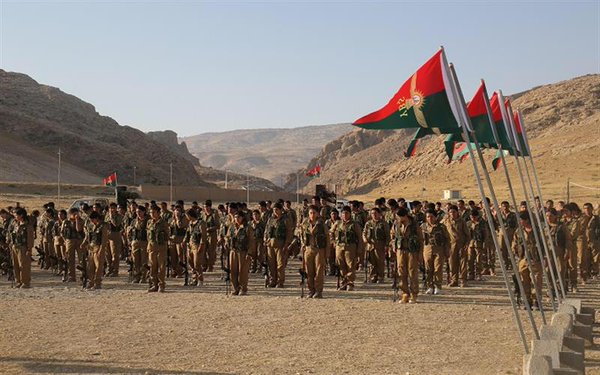
YBS training camp
Therefore, the desire of most of the Yazidis who join the YBŞ is not to support the pan-Kurdish ideology of the PKK, but rather to protect their own homeland and strengthen their capacity for local governance. They simply do not see an alternative sponsor qualified to defend Yazidi interests at the moment. For the Yazidis, the issue is not a choice of loyalty between Erbil versus Baghdad, but is about creating a framework for self-administration—something that Erbil will never tolerate. By rejecting Erbil’s claims to Shingal (something the vast majority of Shingali Yazidis are united in), Yazidis are not expressing some kind of preference for a special relationship with Baghdad. Rather, they simply want to work within the framework of the government that will best provide the opportunity for self-administration.
The KDP had a decade to convince the Yazidis to join with them instead of seeking their own administration under Baghdad. They failed in this endeavor because they used excessive intimidation rather than extending goodwill and respecting the right of the Yazidis to choose. When I was in Shingal in the summer of 2015, I spoke to wheat and barley farmers who had left the camps in Dohuk to temporarily return to their farms on the north side of the mountain, in order to harvest their fields that had been left standing after the genocide. They hoped to sell their grain and return to the camps. But instead of facilitating this effort on the part of the poor families, Peshmerga leaders in charge of the area after the liberation of the mountain’s north side were not allowing Yazidis to bring their grain to Dohuk. (This was prior to the economic blockade discussed in this article.) The Peshmerga leaders were forcing the Yazidi farmers to sell their grain within Shingal, below the current price, to the Peshmerga leaders themselves, who were then transporting it to the Kurdistan Region to sell for a large profit. This is only one example of the kind of corruption that Shingal suffers under single-party rule and it was heartbreaking to see a broken people continue to be subjected to such exploitation even after the genocide.
Today should mark the end of these abuses. The desire of the Yazidis for self-administration within Iraq’s legal framework should now be respected by all sides. The wishes of the Yazidis are not unreasonable or unrealistic. They are not asking to secede from Iraq and create their own country. They simply want to work within the parameters of the Iraqi constitution to effectively manage and protect their historic region. Such goals are sensible—if this minority is to survive in its homeland—and achievable with local and international support.
A New Message from Kurdistan to the Yazidis
At this stage, the KDP has lost the contest for Yazidi loyalty. The best thing for the KRG to do now is to approach the Yazidi community with a new message. Here is the message that President Barzani, the KDP, and all of Kurdistan should give to the Yazidis of Shingal:
– First, we would like to take responsibility for abandoning you in your hour of need, and for allowing the genocide of the Yazidis to take place. We want to apologize in humility for the terrible negligence that left your people defenseless. We should have apologized to you directly, long ago, and we are sorry for the long delay in giving you this honest message. Apologies are painful, but the pain of humility is worth the chance to rebuild trust and good faith with you.
– Second, we recognize that it was not a genocide targeting all Kurds for their ethnicity, but rather targeting Yazidis specifically, for their religious identity. As your brothers and sisters, we stand with you, and we recognize that you alone were targeted with a special project of extermination and enslavement.
– Third, we recognize that no one has the right to choose your leaders for you, except you. Shingal has always been your historic homeland, and you have the right to shape its future. Even after the way that we have broken trust with you, we hope that you will still want seek a future with Kurdistan, but we recognize that the choice is yours, and we will respect whatever decision you make, and will always seek to maintain friendship with you.
– Fourth, we will immediately lift the economic blockade that we have levied against your homeland, Shingal, for the entire past year. We recognize that our actions have further victimized you and inhibited your recovery, even after the terrible trauma of the genocide that you have endured. We do not have the right to tell you not to return to your homeland, or to keep your population in camps for years at a time, while your children grow up hopeless about their lack of a future.
– Fifth, regardless of what political loyalties you democratically choose within your homeland, we pledge to not only allow you free passage with your personal goods from the Kurdistan Region to Shingal, but we also pledge to assist your reconstruction in whatever way we are able, recognizing that after our own negligence, we are now responsible to do what we can to help you rebuild, regardless of whether you place your political loyalties with our parties or not. Kurdistan is contending with economic crisis now, which limits our ability to perform significant reconstruction, but we will do our best to assist you.
– These positions represent the goodwill of the Kurdish people who believe in democracy and justice and this statement represents the Kurdish values of fairness, equality, and integrity.
The purpose of this article has not been to attack Kurdistan, but to address some problems that are weakening social cohesion among communities in Kurdistan and northern Iraq. Kurdistan is a wonderful place with wonderful people who have fought very hard for their own rights and freedoms. On my first visit to Kurdistan years ago, I visited a prison that Saddam had built in which he would imprison Kurds who expressed dissent about their situation. The prison was turned into a museum and I was moved by the depictions of human suffering that the Kurds had endured at the hands of Saddam, and by the bravery of the Peshmerga that had labored so tirelessly to liberate their people. Being honest in our confrontation of new political realities of this generation, and the failure of the Peshmerga in Shingal, does not constitute a denial of the heroism of the Peshmerga over the many years that they have defended Kurdistan. Nevertheless, it is essential that we confront the Ba’thist-like behavior of the asa’ish toward the minority populations, and the political system that looks the other way when abuses occur. Sadly, I have lost some valued friendships with Kurds who are very dear to me, because of the position that I have taken on these issues. It is sad to lose those friendships, but in this context of genocide, I cannot compromise on the truth. In America we say “friends don’t let friends drive drunk.” We can critique government action in Kurdistan because we love Kurdistan and want to see it thrive, just as it is our duty to critique the treatment of minorities in the U.S. whenever our government abuses freedoms. Because of campaigns for the rights of minorities, many people in America today have rights that they did not have a few short years ago. Those rights are always placed in jeopardy when we stop speaking out. My involvement in the Yazidi situation is not that of someone with any stake in political factions. I have never had an affiliation with or affinity for any political group in Iraq, Syria, or Turkey. Rather, I am approaching this situation as a historian who understands how fragile the existence of a minority group like the Yazidis is, and how real the possibility is that the Yazidi people could disappear from the region. We have witnessed the recent decline of many minority communities in the Middle East, not only because of the threat of extremist violence, but also because of the harmful politics of nationalism. It is vital that citizens of Iraq and Kurdistan work to ensure that the Yazidis are not another casualty of politics. You—the people of Kurdistan—must speak out and let your government know that their treatment of the Yazidis is unacceptable and contrary to your values.
The article was originally published in nrttv.com 15/4/2017
Matthew Barber is a PhD student studying Islamic thought and history in the Department of Near Eastern Languages and Civilizations at the University of Chicago. He was working in Kurdistan when the Yazidi Genocide began and later served as the Iraq Executive Director of Yazda for one year in 2015-2016. He has conducted research on the Yazidi minority


